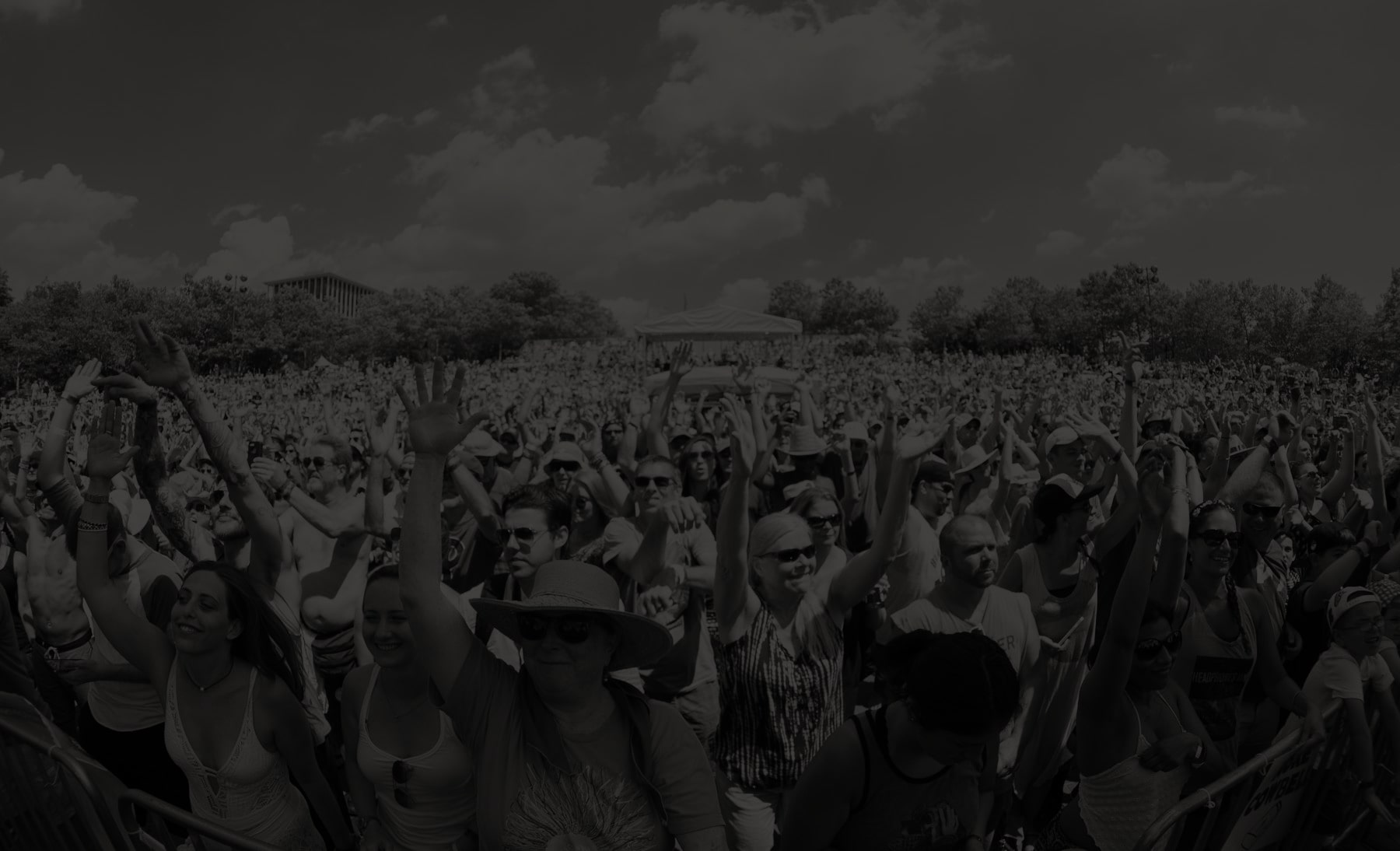
Saying Farewell to a Legendary East Coast Venue: After 35 years, Maxwell’s closes its doors
All photos by Chris Sikich | countfeed.tumblr.com
A rousing cover of Big Star’s “Thank You Friends” was a sincere and apt final song for the occasion last Wednesday in Hoboken, N.J.
On July 31, Maxwell’s closed its doors for good after 35 years of intimate gigs with established and unknown bands of local and international pedigrees. A full house of 200 attendees packed the back room of the restaurant, bar, venue and nexus of alternative musicology for a double-bill curated with an air of history. The first band to ever play the venue, “a,” which had not played its songs since 1978, and The Bongos, a Hoboken band of the past (and the future). As there was a dream for a Hoboken of a time gone by, there is a wealth of evidence for the spirit of Maxwell’s to continue on in bands, other venues and the desires of the public for great music.
“In a lot of ways, Maxwell’s was to Hoboken what J.C. Dobbs on South Street in Philly used to be in the ‘80s and ‘90s and what Johnny Brenda’s is to Philly now — a center of a great local music scene that brought in emerging national bands,” WXPN program director Bruce Warren said. ”I saw one of the earlier Yo La Tengo Hanukkah shows, Freedy Johnston, the Bongos, fIREHOSE; I saw an insane Sonic Youth show there. I was also a fan of Bar/None Records, from Hoboken, which is still thriving, and if one of the bands on the label were playing, I’d go up.”
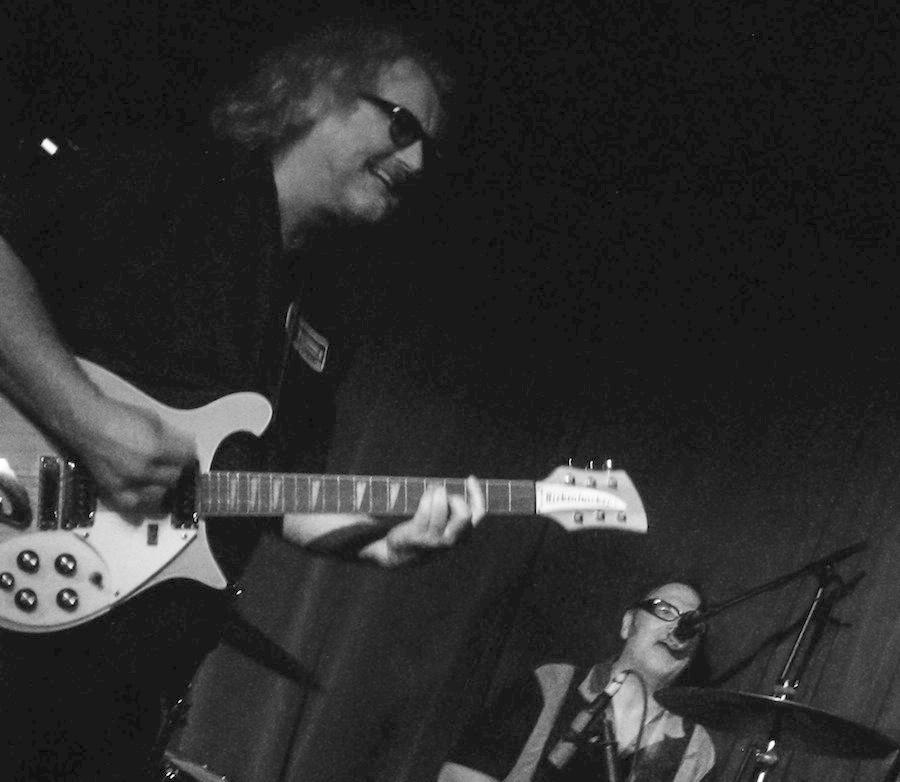
Scott McCaughey performing with Dennis Diken with Bell Sound in August of 2010 | Photo by Chris Sikich | countfeed.tumblr.com
Musicians also eagerly reminisced about their Maxwell’s experiences.
“The closing of Maxwell’s is sad, primarily because of all the essential rock ‘n’ roll memories it brings to me,” said Scott McCaughey, who played there with Young Fresh Fellows, The Minus 5 and The Baseball Project.
McCaughey cited performing “The Gorilla” on the bar, singing with Dennis Diken and Bell Sound, “any number of rabble-rousing Fleshtones shows and especially the many ridiculous Young Fresh Fellows nights, going back to our earliest days.”
Linda Pitmon, who plays drums behind McCaughey in The Baseball Project, said Maxwell’s shows were particularly memorable.
“As a performer I’m going to miss that little thrill I’ve always felt walking in to that small, square, unassuming but perfect rock room,” Pitmon said. “Maxwell’s gigs never cease to stand out in my mind. They don’t become subsumed into the blob of generic shows.”
Glenn Morrow, one of the founders of Bar/None Records and member of two bands that played on the last night of Maxwell’s – “a” and The Individuals – will miss Maxwell’s more as a member of the public than as a performer.
“I’m probably sadder as an audience member,” Morrow said. “I live four blocks away! Even more than being on stage, it was such a great place to see music. I saw so many great shows there: The Feelies, the Replacements, the Gun Club, Mission of Burma, Pylon, Husker Du, the dB’s, They Might Be Giants, Sonic Youth, Big Black, The Fleshtones, Ted Leo. The list is endless.”
The compact size of the club also made it easier to “see bands more up close and personal,” according to singer-songwriter Ken Stringfellow.
“Bands typically played like they owned the place,” Stringfellow said. It was a “great way to relax and act naturally after being in the lens of the tour’s big New York show.”
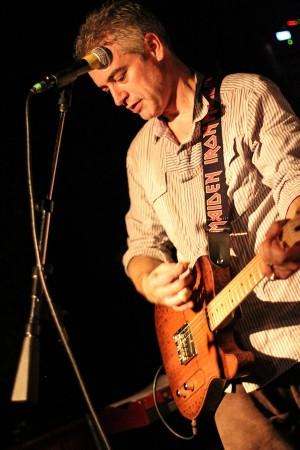
Wesley Stace (as John Wesley Harding) playing Maxwell’s in November of 2011 | Photo by Chris Sikich | countfeed.tumblr.com
Maxwell’s proximity to New York City also weighed heavily on the minds of performers like singer-songwriter Wesley Stace (the artist formerly known as John Wesley Harding) and Sam Hughes of The Spinto Band.
Stace said, “One less great venue in America to play; and one that was so happily close to NYC, but magically didn’t count as an NYC show, one of the reasons so many people played it!”
“Maxwell’s had that small-town classic rock club feeling despite being surrounded by the big-city venues,” Hughes said. “Perfect size, good people and good food.”
This homey atmosphere was cherished by many Maxwell’s performers, including Chris Stamey of The dB’s and Vanessa Briscoe Hay of Pylon fame.
“Maxwell’s was my home away from home for a long time,” Stamey said. “I fondly remember it both for musical and social high points.”
“We always looked forward to performing there,” Hay said. “Steve Fallon, his family and staff were great. They fed us dinner and always made us feel welcome.”
The two main forces behind this small club with, as Hay put it, “a very big heart,” were Fallon and Todd Abramson. Opened in 1978 by Fallon and booked by Abramson since 1986 (except for a brief microbrewery detour in the mid ‘90s), Maxwell’s will be remembered first and foremost as a stellar music venue.
“It was the perfect small rock venue, easy to fill comfortably and fun to watch a show in,” singer-songwriter Robyn Hitchcock said. “Bijou but never scuzzy, it always kept a restaurant atmosphere without blanding into a supper club. Onstage you never had to fight against the cutlery.”
The crowds were always top-notch as well.
McCaughey stated, “Our Maxwell’s crowd was always a step above your normal rock crowd, a bit hipper (but not thoroughly jaded), out for a good time.”
Without Maxwell’s, there will be a void in the live music scene not only in New Jersey and the New York area, but overall, according to Glenn Mercer of The Feelies.
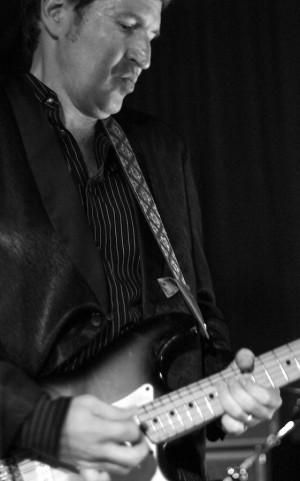
Steve Wynn performs at Maxwell’s with The Baseball Project in April of 2010 | Photo by Chris Sickich | countfeed.tumblr.com
“Maxwell’s was the place where The Feelies spent many memorable nights over the last several decades,” Mercer said. “In the broader sense, it seems to be one of the last intimate, independent clubs that helped nurture the ‘alternative music’ scene.”
Steve Wynn of the recently reunited The Dream Syndicate seconds this sense of emptiness in the live music landscape.
“I’m sad anytime a great club with a great history closes its doors for good,” Wynn said. “And there aren’t any clubs with a longer or more illustrious history than Maxwell’s.”
Warren extends the thought of the loss beyond music itself to a greater hurt to popular culture in general.
“Whenever a live music club closes, it’s a bummer and has a negative impact on the creative cultural economy,” Warren said. “But with a place like Maxwell’s, the bite stings more. Maxwell’s was more than just a local club. It was the epicenter of a vibrant community and its iconic stature transcended the idea that it was just another club putting on shows.”
The closing was first reported in The Star-Ledger in early June. Abramson told the paper that the closing was less about rent and more about the changing nature and economics of the area.
“I am sad that it won’t be part of the future, but it had a good long run in the past,” Hitchcock said. “Hoboken has changed a lot in the last 35 years or so, and perhaps it no longer produces the nutrients to sustain a club like Maxwell’s, and for future generations to pass through it.”
McCaughey pointed to one of the greatest problems with the venue’s existence, which has been cited as one of the many reasons for its closing.
“I will miss it greatly,” McCaughey stated. “The parking, not so much.”
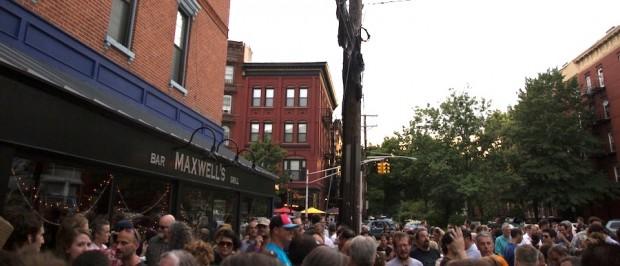
The crowd at the Maxwell’s pre-closing night block party | Photo by Chris Sikich | countfeed.tumblr.com
In Maxwell’s last days, many of its stalwarts took one last lap. Yo La Tengo said farewell to the club June 15 with a double set as Condo Fucks and under its own name. The Feelies played a final three-night stand (July 4-6), while bands with deep roots at Maxwell’s also got playing time throughout the month: Ted Leo, The Fleshtones, and Mission of Burma, among others. Wynn got to add to his total of about 20 shows and Pitmon played twice during the final weeks.
Even though everyone in the venue understood the imminent end of Maxwell’s on its penultimate night of July 30, it was still business as usual. The dinner menu stated it was “The Last Supper” menu, but the prices were not inflated. Lee Ranaldo and The Dust had been sold out for weeks, but Abramson still worked his booking magic by adding up-and-comers Houndmouth as the openers with a second, “secret,” band called Single Dynamite. The roster of the latter included Bob Lawton, a former talent agent for Yo La Tengo and Sonic Youth (among others), drummer Janet Weiss of Sleater-Kinney and Wild Flag fame, and on keyboards, just back from Japan, Ira Kaplan of Yo La Tengo.
The show was fantastic, with Houndmouth ripping through its set with youth and fervor, while Single Dynamite was a curio cabinet of sounds with the phenomenal Weiss expertly playing the drums. And those drums, brandished with a Sonic Youth logo, belonged to SY’s Steve Shelley, co-owner of Maxwell’s. Shelley put on his own drumming clinic while Ranaldo and company rocked out to new tunes and old, including Sonic Youth’s “Genetic” and covers of songs originally by David Crosby, Talking Heads, Modern Lovers, and Neil Young. Ranaldo got in some clichés, including comparing the show to an Irish wake, and excellent rock music all around.
Of course, this doesn’t mean that someone in the future won’t make money off of this history, as Stringfellow suggests.
“Probably there will be a coffee table book about it,” Stringfellow said. “Then it will be bought, reopened with less charm. Or worse, as ‘Live and work in what was once one of Hoboken’s legendary venues: the Maxwell’s Lofts.’ ”
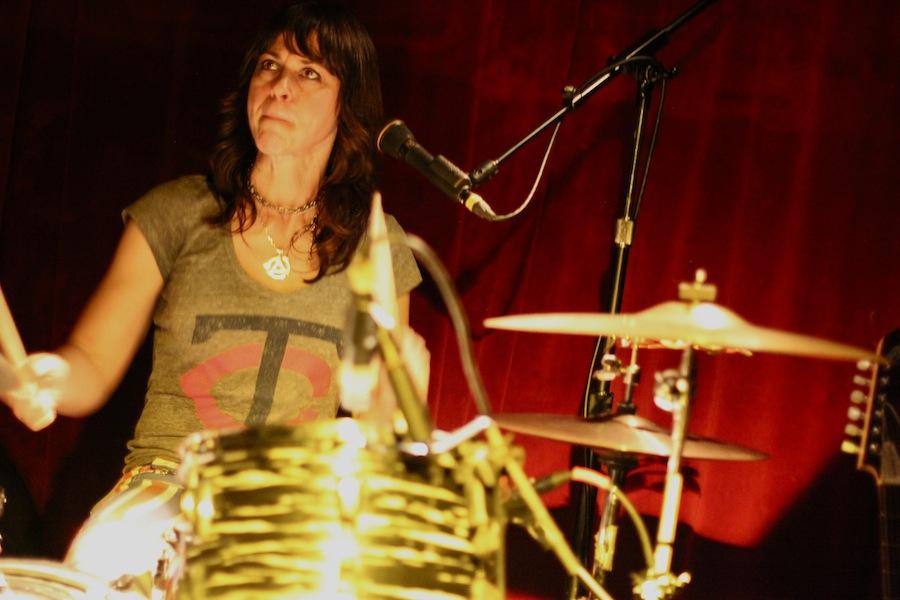
Linda Pitmon plays Maxwell’s with The Baseball Project in April of 2010 | Photo by Chris Sickich | countfeed.tumblr.com
History is rarely as preconceived as the July end of Maxwell’s. This was shown to be true as a gentleman got on stage prior to Lee Ranaldo and The Dust to propose marriage to a woman whom he had met at Maxwell’s years before. She said yes, just as many other couples who met there have. Kaplan and Yo La Tengo bandmate Georgia Hubley famously met there at a Feelies show in 1980. And then there is the story of Pitmon and Wynn.
“I’ve played Maxwell’s numerous times since my first show around 1990 but the most memorable was June 24, 1992, when I was on tour with my Minneapolis-based trio Zuzu’s Petals,” Pitmon said. “We were opening for Steve Wynn and his amazing band. I was a huge fan of Steve’s music so I was quite excited! Our show went well and I really enjoyed his set but what I’ll always remember about Maxwell’s is that it was the first time I met Steve — my future husband.”
Wynn added, “Thanks for that booking, Todd!”
On Wednesday, July 31, there was one final booking, for two shows, and a block party to honor Maxwell’s history and closing. Abramson ran it all as classy as possible. Were there collector’s items to purchase to commemorate the end? No, not really, as the T-shirts for sale were the standard Maxwell’s shirts that had been for sale for years. Were ticket prices at a premium? Considering tickets for both shows, priced at $10 each, did not go on sale until that day and that loyal Maxwell’s customers had gotten email invites to purchase tickets a little ahead of time, it would not be a final money grab at all.
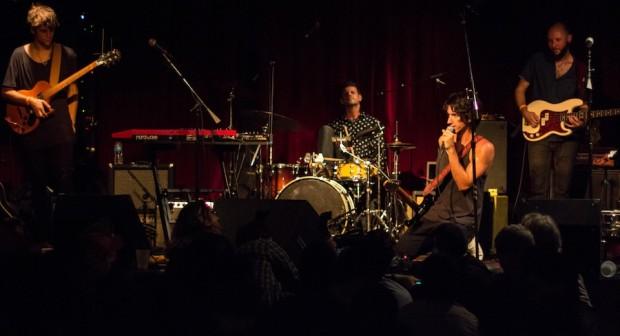
Delicate Steve frontman Steve Marion urges the crowd to sit and feel the Maxwell’s floor one last time | Photo by Chris Sikich | countfeed.tumblr.com
Until the end it was music for music lovers at the prices they had come to expect. The only shock to anyone was the lack of tables inside the dining area of the venue, but this was a smart way to allow as many people in for at least a gander or a drink before the doors closed.
While local DJs spun records outside, including Kaplan, four bands played inside. The first bill of Delicate Steve and The Individuals paired a group that had never played Maxwell’s before (the former) and a group that had disbanded 30 years ago (the latter). Delicate Steve’s technical skill was at the forefront, but the moment its frontman Steve Marion asked the crowd to sit on the floor and feel the floor for one last time will forever stick with those in attendance. The jangle-pop sound of The Individuals was a delight, but this was overshadowed by an unexpected appearance by Tricia Wygal, who, along with Janet Wygal of The Individuals, was in the band Splendora. They covered the Splendora song “You’re Standing on My Neck” — aka the theme song to Daria — in angst-ridden perfection. Before the end of their set, Kaplan, Hubley and Fallon, among others, joined the band on stage.
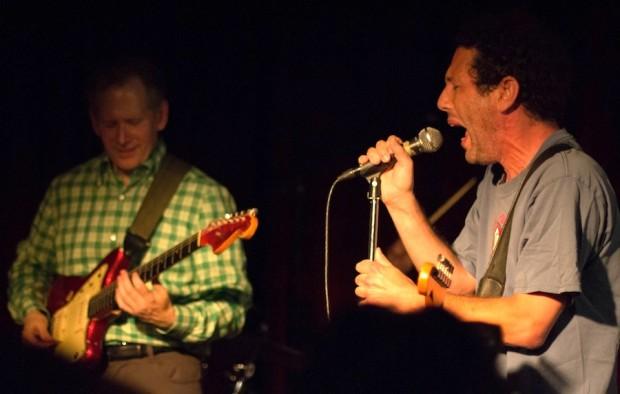
Yo La Tengo’s Ira Kaplan performs at Maxwell’s closing night with The Individuals | Photo by Chris Sikich | countfeed.tumblr.com
And then there were two more bands to take Maxwell’s stage. “a,” which was led by Morrow and Richard Barone, began the end with music that Morrow said was by “young kids who thought we could reinvent the wheel of popular song.” The avant-garde nature of the music – paired with Morrow talking as if it were still 1978 “with the PATH train to New York City costing 25 cents and rent going for $65 a month” – gave the set a timeless feel. To put an exclamation point on this odd and glorious set, bassist Rob Norris entered the crowd with the band’s pylon that had the letter “a” affixed to it, signifying the band’s exit back into the history of Maxwell’s.
Then Hoboken’s The Bongos took the stage. Led by Barone, Norris, “a” drummer Frank Ginnini, and James Mastro, they worked through its catalog of 1980s rock riffs to a crowd that had barely known them since their last record came out 1985. Sure, they had performed very sporadically since, but they too were a piece of Maxwell’s past. They revealed two surprises, though: they were dropping a single on Aug. 1 (listen to it via Spin.com) and would be releasing an album in October of material from the mid-1980s that, when played during this final show, showed that they have quite a bit of steam as a rock band in 2013.
The encore brought much celebration and a little sadness as Kaplan, Hubley and Fallon again came to the stage as well as another surprise in Mercer as well as Abramson himself. A highlight reel of The Velvet Underground’s “Rock & Roll” and Paul Revere & The Raiders’ “Kicks” led into the finale of Big Star’s “Thank You Friends.”
It was certainly a monumental end to a grand venue. But its spirit is destined to live on. Abramson, who also books the glorious Bell House in Brooklyn, said in an interview with The Wall Street Journal that he is looking into Jersey City for his next music venture. And beyond whatever Abramson does, there is always hope for great venues in the future, as Stamey and Wynn suggest.
“A club is defined by the people more than the space,” Stamey said. “As long as Todd Abramson is still curating the musical nightlife of Metropolis, with his club the Bell House in Brooklyn and whatever new venues he has down the road, then the aesthetic of Maxwell’s will still have a voice.”
Wynn added: “Yes, I’ll certainly miss Maxwell’s and cherish all of the memories, but the end of one club means the time to find another new great club to start building a new history. And the road goes on and on.”